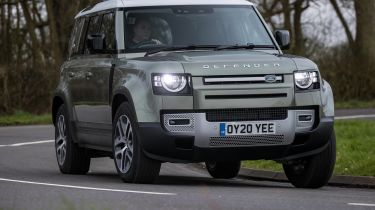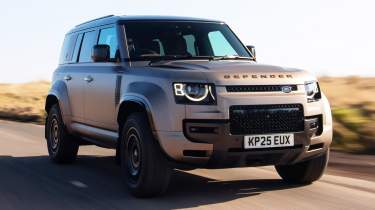Land Rover Defender review - Engines, drive & performance
"The Land Rover Defender has a wider range of talents than almost any other vehicle on sale"
It might be one of the best loved models of all time, but one thing the Defender was never famous for was its everyday performance. Enough low-down grunt to get up steep banks and tow a trailer, yes, but not straight-line speed away from the lights.
With a more advanced powertrain, the new Defender has a far broader set of talents. Its advanced adaptive four-wheel drive and air suspension (on top trims) ensures it's still capable of traversing the world's most inhospitable terrain, but it can also tear from 0-62mph in as little as 3.8 seconds with a brawny turbocharged V8 engine fitted.
Just as impressive as its on-paper statistics, there's the fact it's simply fun to drive as well. Many have questioned whether the new Defender would tread on the toes of the Discovery, and it’s easy to see why. From behind the wheel the Defender instantly makes you smile; its steering is more alert, and while the suspension is a little firmer, there’s more feedback flowing back through your fingertips and the seat as you drive. It makes the incredibly capable Disco feel almost redundant.
Attack a British road, and the Defender feels surprisingly sporty, digging its front tyres into the road with lots of grip on offer. It's remarkably composed too; the fact the body leans slightly through faster corners and the nose lifts under acceleration only seems to add to its character. To cope with its extra power, the V8 version is fitted with upgraded suspension components, plus a limited-slip differential and new traction control software, which only enhance the driving experience. It feels stable and quite engaging in corners, with a smoother ride than the Mercedes G-Class.
More reviews
Yet, the same suspension can transform to scale ruts, wade through deep water and absorb torturous bumps. Every Defender is fitted with an eight-speed automatic gearbox that also has low-range ratios designed specifically for off-road driving and towing. At Eastnor Castle's off-road experience centre, sections have been opened up for the first time in a decade to test the Defender's extreme capabilities. A set of tortuous undulating water-filled pits is a particular challenge, and just when you think the Defender is about to get stuck, its Terrain Response 2 software modulates power to the wheels to find just enough traction to drag it out the other side.
Designed around Land Rover's new D7x platform that's incredibly stiff - and has been subjected to years of rigorous testing during its development - the Defender has approach and departure angles of 38 and 40 degrees respectively, along with a 900mm wading depth. It can tackle 45-degree side slopes and inclines, and its trick assistance systems can be used to adjust the chassis and differentials manually or simply be left in Auto, where it recognises the surface you're driving on.
An even more extreme model, badged the Land Rover Defender Octa was launched later, and boasts a scarcely believable 616bhp thanks to a twin-turbocharged mild-hybrid assisted V8 engine. It’s undeniably overkill for an off-road SUV, but it’s impressive nonetheless. Not only is it fast, but the Octa sits on different hydraulic suspension which is 28mm higher than that of the regular car, and can be raised by 75mm to make it easier to wade through high water. Stick on tarmac, though, and the Octa is supremely capable, too, thanks to beefier brakes, tweaked steering and unique wheels and tyres that give it a sharper feel.
The Defender Octa may be expensive, but it may be one of the most versatile cars on sale. It’s simply blisteringly quick, good to drive and yet off the beaten track you can keep giving it the beans like a wild rally car and it will take everything you throw at it.
Land Rover Defender diesel engines
The Defender launched with two versions of the 2.0-litre 'Ingenium' diesel engine, badged D200 and D240. The latter (237bhp) is more powerful than the former (197bhp) but both get a healthy 430Nm of torque to help with tricky terrain or when pulling heavy loads. Each gets an automatic gearbox and permanent four-wheel drive as standard, with the faster car capable of 0-60mph in 8.7 seconds.
However, these engines were replaced very early in the Defender’s lifecycle, with Land Rover switching the four-cylinder units for punchier 3.0-litre straight-six diesel engines equipped with mild-hybrid hardware. These were badged D200 (again, with 197bhp), D250 (serving up 247bhp), and D300 (with 296bhp). Acceleration from 0-62mph takes 10.2s, 8.3s and 6.7 seconds respectively for the mid-length Defender 110, with the lighter 90 slightly quicker and the longer, heavier 130 a little slower.
The D200 and D300 engines have since been discontinued, the latter replaced by a more powerful D350 engine in 2024. It uses the same 3.0-litre straight-six as before, but with a hefty power bump up to 345bhp. As a result, the 0-62mph time for an equivalent Defender 110 drops marginally to 6.3 seconds.
Petrol engines
Unlike the previous iteration of Defender, buyers also had the option of two petrol engines from launch, badged P300 and P400. The smaller 2.0-litre turbo gets 296bhp, propelling the car from 0-62mph in 7.1 seconds, while the 3.0-litre straight-six P400 mild-hybrid has 395bhp and gets to 62mph in six seconds.
The 48-volt mild-hybrid electrical assistance tech is designed to harvest the energy normally wasted under deceleration and store it in a small lithium-ion battery. This can be used to bolster the engine's torque under acceleration, or switch off the engine more of the time when waiting in traffic.
It's fun to drive, with a tuneful sound and impressive acceleration. Interestingly, there are no steering wheel-mounted paddles for the automatic gearbox, as engineers don't feel they fit the Defender ethos, but you can nudge the gearstick to shift manually. The engine and steering again feel surprisingly willing for a big, heavy SUV.
Both P300 and P400 petrol engines were discontinued in 2024 due to tightening emissions regulations, replaced instead by a new V8 engine, labelled P425. This 5.0-litre V8 is a detuned version of the engine fitted to top-spec Defender ‘V8’ models.
Speaking of, the Defender V8 version should be even more capable. With 518bhp and a 0-62mph time of 5.2 seconds, it's undeniably quick. Considering its boxy shape, a 149mph top speed is particularly attention-grabbing. To make the most of its extra power, the V8 Defender also gets a new active electronic differential, upgraded suspension and a toughened gearbox. Its Terrain Response 2 system also gains a new Dynamic mode for enthusiastic driving on-road.
And yet, that’s not even the most raucous version of the Defender available. The Defender Octa comes with a 4.4-litre mild-hybrid assisted and twin-turbocharged V8 engine that boasts 616bhp and a scarcely-believeable 0-62mph of just 3.8 seconds. What’s even more impressive about these figures is that the Defender Octa isn’t just limited to flaunting them on the road, but will put that power down along a gravel track, too – if you’re brave enough to do that with £160k worth of car, mind.
Plug-in hybrid engines
The now-discontinued Defender P400e plug-in hybrid uses a 2.0-litre petrol engine, electric motor and a 19.2kWh lithium-ion battery. With a combined 398bhp, it's only a few tenths slower than the V8 model, getting from 0-62mph in 5.6 seconds. Unfortunately, the P400e was limited to the Defender 110 model, but air suspension and 20-inch alloy wheels came as standard.
Despite the extra weight of its battery, the P400e still feels sharper than expected on the road, with quicker steering responses than the Land Rover Discovery. In Hybrid mode, the powertrain decides how to juggle between its power sources and it's hard to detect the changes from behind the wheel.
The petrol engine can sound a bit coarse under hard acceleration but this is also the quietest Defender when driven sedately, particularly in EV mode. The electric motor alone can power the SUV at up to 87mph but at higher speeds wind noise is noticeable because of the Land Rover's boxy shape.
In 2024, the P400e was phased out and a new P300e engine was introduced in its place. It uses the same 2.0-litre petrol engine and electric motor combination, although detuned to 296bhp. As before, it’s only available for Defender 110 models.











